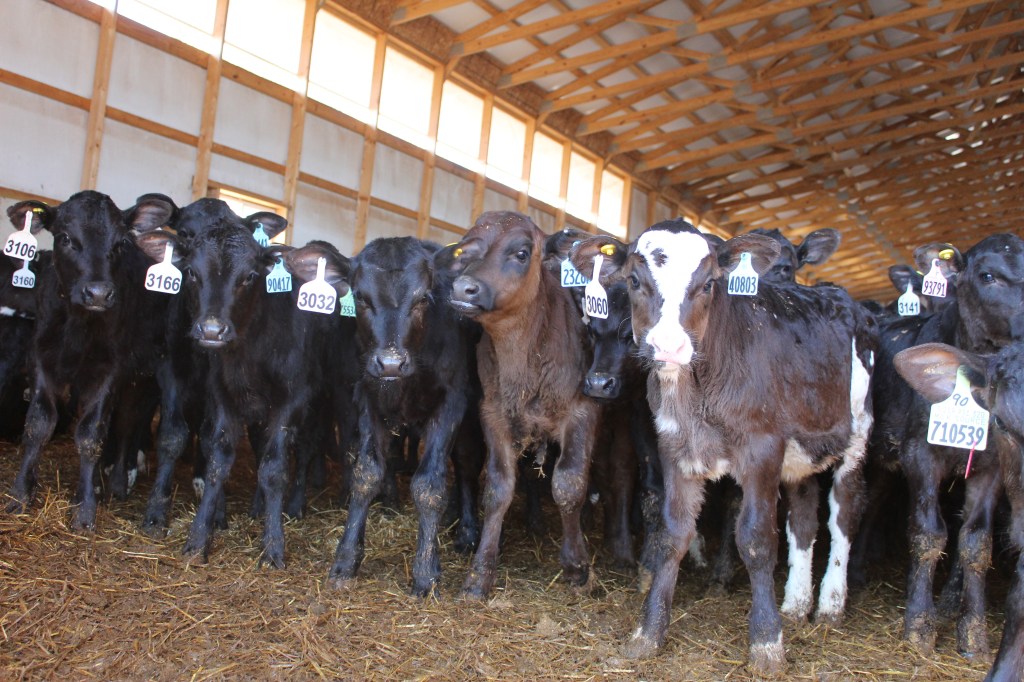Think of the meat case at your local grocery store. Now, head to the beef section. What do you see? At first glance, you may see some tasty beef you’ll take home to put on the grill. However, upon closer inspection, ‘Black Angus’ beef labels might cover the case.
The Angus breed has taken the beef industry by storm in terms of getting consumers to associate black hided cattle with the absolute best beef. It is not to say that Angus cattle do not produce great beef. They do! Their breed has a reputation for excelling at carcass traits like marbling and ribeye area. In fact, Angus cattle are known for their potential to produce high quality and tasty beef.
But, the secret to tasty beef is not the hide color of the cattle, but rather their genetic makeup.

That’s where our conversation starts today. It is not new to hear of beef cross calves entering the beef supply chain. We harvest more beef cross calves today than ever before as dairies shift to a sexed and beef strategy. As a leading genetic company, ABS Global hears the concerns of white markings occasionally found on beef cross cattle. With the premiums that can sit at the packing plant for black hided cattle, those concerns are valid. Allow us to help make some sense about hair coat color.
[READ: Beef Sires Increase Dairy Profitability]
What determines hide color?
The answer is genetics. When cattle are tested as homozygous black, the test is based on the gene that is responsible for red verse black hide color. White is not considered. There are also other genes responsible for diluting that base color, sometimes making cattle gray, adding brindle, or spots. In the common U.S. beef breeds, there are at least seven genes associated with color inheritance (and likely others that also play a role) and each gene exerts varying impacts on the color of cattle. Hair coat color in cattle is not as simple to pinpoint in DNA as one might think.

Hair coat color is also related to the genetic material that is passed from parent to offspring. We often forget that a sire contributes 50% of the genetic makeup of a calf while the dam supplies the other 50%. The Holstein dam’s genetic makeup plays a role in why we see occasional white markings in beef cross calves.
Does hair coat color impact profit in the supply chain?
The simple answer is that excessive white markings can be an economic driver for those selling day old calves or calf growers selling to a feed yard. We understand that calf buyers use coat color to avoid purebred Holstein genetics from entering the beef supply chain. Coat color has historically been used as a proxy to identify the genetic merit of animal because it is easy to observe, unlike marbling or other meat quality characteristics. This means cattle producers are subject to discounts for excessive white, but the true value of the carcass produced is based on their genetics.
If we go back to our meat case scenario, a consumer never sees the hair coat color of the harvested animal. Hide color is not a determining factor in if the consumer will purchase the beef or not. You know what is: high quality red meat. The red meat they see in the case motivates them, and the reality is all animals harvested in the beef supply chain are the same color under their hide. The animal’s genetics determine is the quality of carcass they will produce.
Hair coat color should not be your only consideration when producing or procuring beef cross calves.

We know that not all beef cross calves are created equal. While the desire for black hided cattle is apparent, red cattle and cattle with white markings can yield just as high-quality carcasses. Your selection should reach beyond the limit of hide color and focus on the genetic quality you chose to deploy.
[PURCHASE: Sexcel Sexed Semen]
As a dairy producer, knowing what’s under the hide of your beef cross calves is just as important as their hair coat color. Trust the ABS shield for the right beef genetics for YOUR dairy. Be confident in the value of beef cross calves you create with our Beef InFocus program, the only program bred by design with YOUR dairy and beef supply chain profitability in mind.
Sign up to learn more about Beef InFocus!






